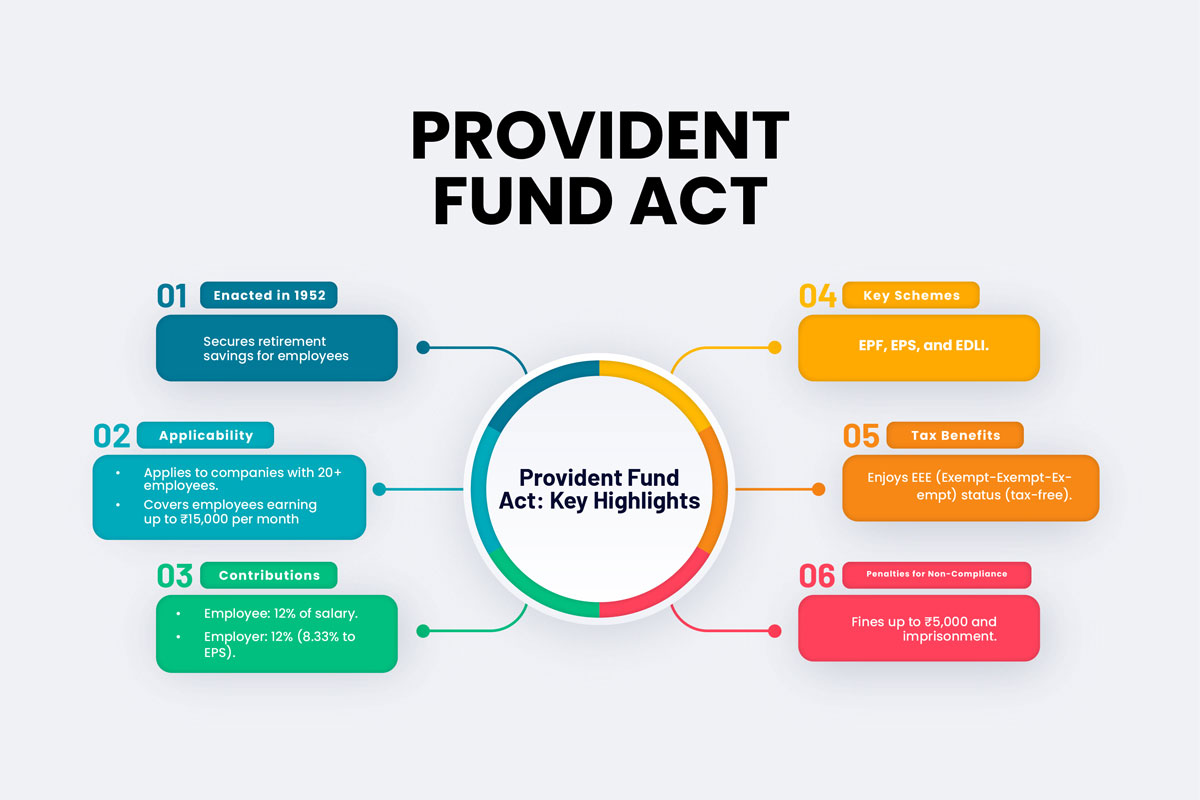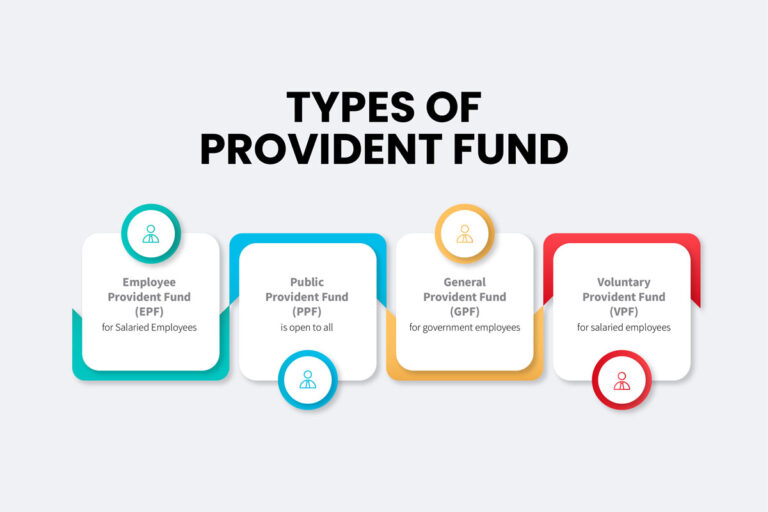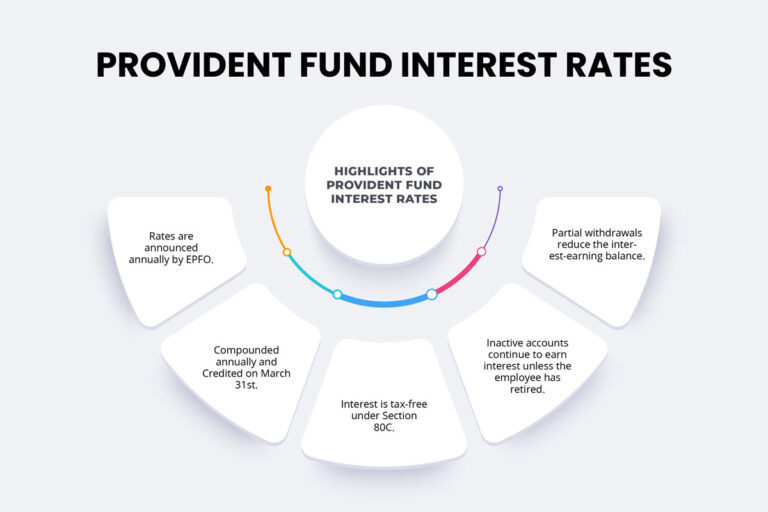
The Provident Fund Act, officially known as the Employees’ Provident Fund and Miscellaneous Provisions Act of 1952, is a crucial legislation governing employees’ savings in India. The Act ensures financial security for employees by requiring both employers and employees to contribute to a provident fund. This comprehensive blog delves into the key aspects of the Provident Fund Act, its provisions, and its importance for employees and employers.
The Provident Fund Act is pivotal in ensuring the financial security of employees in India. It mandates that companies with a specified number of employees must contribute to the Employee Provident Fund (EPF), encouraging systematic retirement savings. The Act covers various topics, including contribution amount, employee eligibility, and business compliance requirements.
The Employees’ Provident Fund and Miscellaneous Provisions Act 1952 aims to protect employees’ retirement savings by requiring regular contributions from both the employer and the employee.
History and Background of the Provident Fund Act
The Origin of the EPF Act 1952
The Employees’ Provident Fund Act of 1952 protected employees’ post-retirement financial interests. Before this legislation, there was no structured system for retirement savings. The Act provided a systematic, long-term savings mechanism to support employees after retirement.
Evolution of Provident Fund Laws in India
Since its inception, the Provident Fund Act has undergone several amendments to accommodate the changing socio-economic environment. Today, the Act is a vital component of the provident fund regulations in India and covers not just provident funds but also pension schemes and insurance for employees.
Purpose of the Provident Fund Act
The primary purpose of the Provident Fund Act is to safeguard employees’ savings. This is achieved through mandatory contributions from employees and employers, accumulating with interest over time and serving as a financial cushion in retirement, illness, or other emergencies.
Boards and Governance
The Employees’ Provident Fund Organisation (EPFO)administers the Provident Fund Act. There are two key boards involved in managing and implementing the Act’s provisions:
Central Board of Trustees:
- Functions: The Central Board oversees the implementation of the EPF Act and manages the funds under it.
- Key Members: Includes representatives from the government, employers, and employees.
State Boards:
- Functions: State boards work alongside the central board to ensure smooth provident fund administration within their respective states.
- Key Members: Like the central board, state boards have representatives from various sectors.
The boards operate schemes below:
- Employees’ Provident Fund Scheme (EPFS),
- Employees’ Pension Scheme (EPS)
- Employees’ Deposit Linked Insurance Scheme (EDLI).
Key Provisions of the Provident Fund Act
The Employees’ Provident Fund and Miscellaneous Provisions Act 1952 outlines various provisions to safeguard employees’ retirement savings and ensure employer compliance. These provisions detail how contributions are made, who is eligible, and what compliance measures employers must follow. Below is an explanation of the Act’s key provisions, including mandatory contribution rates, penalties for non-compliance, and more.
1. Employee Provident Fund (EPF) Scheme
The EPF Scheme, as outlined under Section 6 of the Provident Fund Act, mandates that employers and employees contribute a fixed percentage of the employee’s salary to the EPF account. These contributions accumulate with interest over time and serve as the employee’s retirement corpus.
Contribution Rates:
- Employee Contribution: Employees contribute 12% of their basic salary and dearness allowance (DA) to the EPF, which is directly deducted from their salary.
- Employer Contribution: The employer matches this 12% contribution, but not all of it goes to the EPF. Only 67% of the employer’s contribution goes to the EPF, while 8.33% is directed to the Employees’ Pension Scheme (EPS).
Contribution less than 12%
- For certain industries with fewer than 20 employees or industries listed under Schedule II of the Act, the contribution rate is lower at 10% for both the employer and the employee.
- The 10% contribution rate also applies to establishments in the following industries: Jute, Beedi, Brick, Coir, and Guar gum factories.
- The 10% contribution rate also applies to organisations with losses more than or equal to the net worth at the end of the fiscal year.
- The 10% contribution rate applies to organisations declared ill by the Board for Industrial and Financial Reconstruction.
2. Employees’ Pension Scheme (EPS)
The Employees’ Pension Scheme (EPS) was introduced in 1995 as part of the Provident Fund Act. Employers contribute 8.33% of the employee’s salary (subject to a salary cap of ₹15,000 per month) to this scheme, which provides pension benefits to employees after retirement.
3. Employees’ Deposit Linked Insurance Scheme (EDLI)
Another key feature of the Provident Fund Act is the Employees’ Deposit Linked Insurance (EDLI) Scheme. This scheme provides insurance benefits to employees in case of death during service.
- EDLI Contribution:
-
- The employer contributes 0.5% of the employee’s salary, up to Rs.75 per month, toward the EDLI scheme, ensuring that the nominee receives a lump sum amount in case of the employee’s untimely death.
-
- The maximum insurance coverage under the EDLI scheme is currently ₹7 lakh.
4. Interest Rate on EPF Contributions
The EPF balance, which includes both the employer’s and the employee’s contributions, earns interest at a rate determined annually by the Central Board of Trustees (CBT) in consultation with the Union Finance Ministry. The provident fund interest rate for the financial year 2023-24 is 8.25%. The interest is compounded yearly and credited to the employee’s account at the end of the financial year (March 31st).
5. Universal Account Number (UAN)
Introduced in 2014, the Universal Account Number (UAN) is a unique 12-digit number provided to all employees contributing to the EPF scheme. The UAN allows employees to manage multiple provident fund accounts across different employers under one umbrella.
- Benefits of UAN:
-
- Employees can view their EPF balance, contributions, and interest earned.
-
- It simplifies the transfer of funds between old and new EPF accounts when changing jobs.
-
- Employees can withdraw their EPF balance or apply for loans online using the UAN portal.
Compliance Requirements Under the Provident Fund Act
The Provident Fund Act places several obligations on employers to ensure compliance. These include timely contributions, accurate record-keeping, and submission of statutory reports.
1. Employer Registration with EPFO
Every employer covered under the Act must register with the Employees’ Provident Fund Organisation (EPFO). This ensures that both employer and employee contributions are tracked and managed efficiently.
- Online Registration: Employers can register with the EPFO through the EPFO’s Unified Portal, which facilitates the online submission of contributions and compliance reports.
2. Timely Contributions
Employers are required to deposit their and their employee’s contributions to the EPF account by the 15th of each month. Late payments can result in penalties and interest charges.
- Interest on Late Payments: Employers who fail to make timely contributions are liable to pay 12% interest annually on the amount due. Repeated delays or non-payment may lead to legal action, including fines and imprisonment.
3. Filing Monthly Returns
Employers must file monthly returns detailing their EPF contributions through the EPFO portal. This ensures transparency and enables employees to track their provident fund balance through their UAN.
4. Penalties for Non-Compliance
Employers who do not comply with the provisions of the Provident Fund Act face severe penalties. Under Section 14 of the Act:
- A fine of up to ₹5,000 can be imposed for failing to make contributions.
- Employers who default or engage in fraudulent activities related to EPF contributions can be imprisoned for six months to one year.
Overview of Key Provisions in a Table:
| Provision | Details |
| Employee Contribution | 12% of basic salary and DA (10% in specific cases) |
| Employer Contribution | 12% (3.67% to EPF, 8.33% to EPS) |
| Interest Rate on EPF | 8.25% for the financial year 2023-24 |
| Eligibility for EPF | Mandatory for employees earning up to ₹15,000/month |
| EDLI Insurance Coverage | Up to ₹7 lakh in case of death during service |
| UAN | Universal Account Number for tracking multiple EPF accounts |
| Penalty for Late Payment | 12% interest per annum on late contributions |
| Penalty for Non-Compliance | Fine up to ₹5,000 and imprisonment from 6 months to one year. |
Non-Applicability of the PF Act
- Small Establishments: Establishments with fewer than 20 employees are exempt from mandatory coverage unless they voluntarily opt for it.
- International Workers: International workers from countries with which India has signed a Social Security Agreement (SSA) are exempted from contributing to the EPF if they are covered under a similar social security scheme in their home country.
- Employees of Statutory Bodies: Employees of statutory bodies and corporations set up under special acts are exempt from the Act, as they may have provident fund schemes.
Key Statistics:
According to the Ministry of Labour, the EPFO covers 393824 establishments and over 11.80 crore EPF Members.
How the Provident Fund Act Benefits Employees
The Provident Fund Act offers several benefits to employees, ensuring financial security and a stable retirement fund.
1. Retirement Savings and Financial Security
The primary objective of the Provident Fund Act is to create a retirement fund for employees through regular contributions from both the employee and employer. This accumulated corpus, with the added interest, serves as a significant financial cushion for the employee upon retirement. The interest rate for the financial year 2023-24 is 8.25%, one of India’s highest interest rates for fixed-income savings instruments.
2. Tax Benefits Under Section 80C
One of the major advantages of the EPF scheme is its EEE (Exempt-Exempt-Exempt) status under the Income Tax Act:
- Contributions to the EPF are eligible for deductions under Section 80C, up to ₹1.5 lakh annually.
- The interest earned on the EPF balance is tax-free, provided the employee completes 5 years of continuous service.
- The maturity amount, including contributions and interest, is also exempt from tax.
3. Social Security and Protection
The Provident Fund Act helps employees handle financial emergencies through provisions for partial withdrawals:
- Employees can withdraw from their EPF for specific purposes, such as medical treatment, higher education, or buying a house.
- The Act also includes the Employees’ Pension Scheme (EPS), which provides a monthly pension to employees after retirement, thus securing their financial future.
4. Insurance Through the EDLI Scheme
Employees receive life insurance coverage under the Employees’ Deposit Linked Insurance (EDLI) scheme. In the event of an employee’s death during service, their nominee is entitled to a lump sum insurance payment, which is currently capped at ₹7 lakh.
Key Statistics:
In the first quarter of 2024-2025, the EPFO settled 13.6 million claims, 25.1% higher than the previous year.
Employer Obligations Under the Provident Fund Act
The Provident Fund Act places several responsibilities on employers. Non-compliance can lead to severe penalties, both financial and legal.
1. Timely Registration and Compliance
Employers must register their establishment with the EPFO within one month of reaching the 20-employee threshold. Employers are also required to submit monthly returns and maintain accurate records of contributions.
2. Timely Contribution of EPF Dues
Contributions must be deposited by the 15th of every month to avoid penalties. Late contributions attract interest at 12% per annum and penalty charges under Section 7Q and Section 14B of the EPF Act.
3. Consequences of Non-Compliance
Employers who fail to meet the provisions of the Act face significant penalties:
- Fines: Non-compliance can result in fines of up to ₹5,000 for each offence.
- Imprisonment: In cases of willful default, the employer can face imprisonment of up to 3 years.
Recent Amendments and Updates to the Provident Fund Act
The Provident Fund Act has evolved significantly over the years to accommodate the changing dynamics of India’s workforce.
1. Introduction of Universal Account Number (UAN)
The Universal Account Number (UAN) was introduced to streamline the management of multiple EPF accounts. It allows employees to link their provident fund accounts across various employers, ensuring seamless funds transfer when they change jobs.
- UAN Portal: Employees can access their UAN through the EPFO UAN portal, enabling them to track their contributions, withdraw funds, and transfer balances.
- Online EPF Claims: Employees can file claims for withdrawal or transfer online through the UAN portal.
2. Higher EPS Pension Calculation
In 2022, the Supreme Court ruled favouring employees who wanted to opt for a higher pension under EPS. Earlier, the pension under EPS was calculated based on a salary cap of ₹15,000. Still, employees who earn more can now receive a higher pension if they opt-in and make contributions based on their actual salary.
- This amendment significantly increases the pension benefits for employees earning a higher salary, enhancing their post-retirement financial security.
3. EPF Contribution Relief During COVID-19
During the COVID-19 pandemic, the government relieved employers and employees by reducing the EPF contribution rate from 12% to 10% from May to August 2020. This was done to ease the financial burden on both employers and employees during the economic slowdown.
The Provident Fund Scheme was amended to allow for a COVID-19 non-refundable advance of up to 75% of members’ total PF contributions or a sum of their three months’ wages, whichever was less.
4. Online Compliance and e-Signatures
Recent amendments have made it easier for employers to comply with EPF regulations through online filings, e-signatures, and digital payments. This ensures faster processing and reduces administrative overhead.
Future Outlook:
Discussions are ongoing regarding expanding EPF coverage to the gig economy and self-employed individuals. This could result in amendments further to broaden the scope of the Provident Fund Act to include freelancers and gig workers.
Conclusion
The Provident Fund Act is a cornerstone of employee savings in India, ensuring financial stability for millions of workers. Understanding the Act’s provisions and ensuring compliance with the EPF Act 1952 is crucial for employers and employees to maximise the scheme’s benefits.






